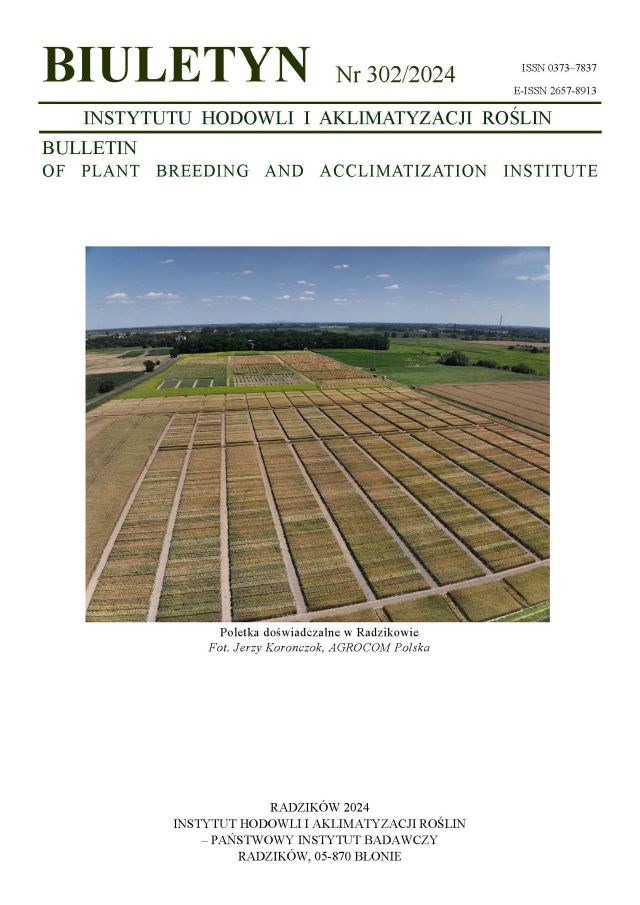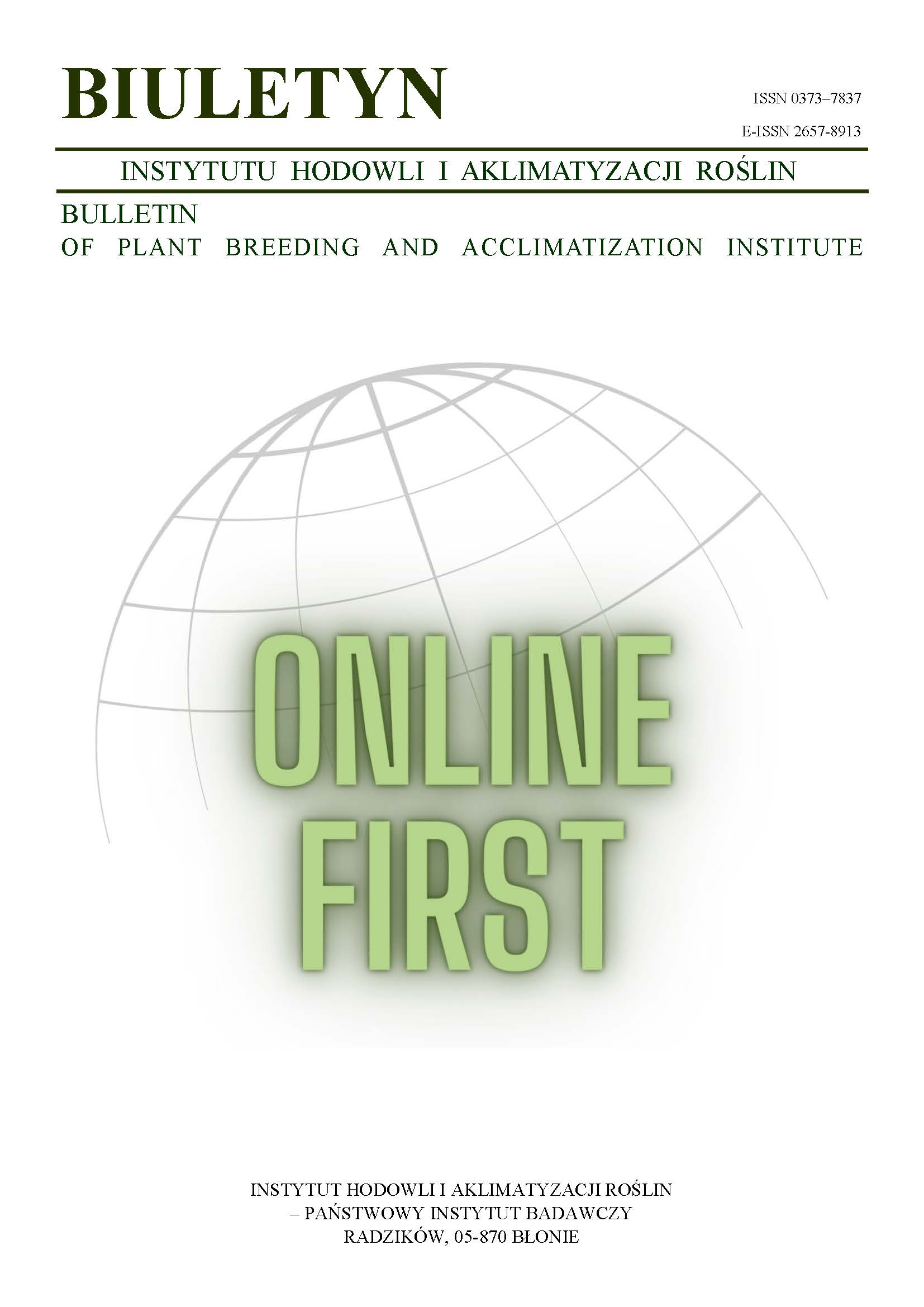Evaluation of inbred lines of maize on the basis of specific, foreign and general selection indices
Henryk Bujak
henryk.bujak@upwr.edu.plKatedra Hodowli Roślin i Nasiennictwa, Akademia Rolnicza we Wrocławiu (Poland)
Stanisław Jedyński
Katedra Hodowli Roślin i Nasiennictwa, Akademia Rolnicza we Wrocławiu (Poland)
Jan Kaczmarek
Katedra Hodowli Roślin i Nasiennictwa, Akademia Rolnicza we Wrocławiu (Poland)
Abstract
Studies were carried out on 20 inbred maize lines at two locations: Kobierzyce and Smolice. The following characters: plant height, ear length, no. of rows/ear, no. of' grains/ear and grain weight/ear were included in the construction of three selection indices: specific (Is), foreign (IO) and general (IOG). The results indicated that specific index was the most efficient. Expected genetic advance was lower when foreign index was used. Adequate evaluation of general index could not be made because of insufficient experimental data.
Keywords:
inbred lines, maize, selection indicesReferences
Bujak H., Jedyński S., Kaczmarek.J. 2004. Zastosowanie indeksu selekcyjnego do oceny wartości hodowlanej. Rozprawy i Monografie Instytutu Genetyki Roślin PAN: 207 — 222.
Google Scholar
Caldwell B. E., Weber C. R. 1965. General, average and specific selection indices for yield in F4 and F5 soybean populations. Crop. Sci. 5: 223 — 226.
DOI: https://doi.org/10.2135/cropsci1965.0011183X000500030007x
Google Scholar
Hanson W. D., Johnson H. W. 1957. Methods for calculating and evaluating a general selection index obtained by pooling information from two or more experiments. Genetics 42: 421 — 432.
DOI: https://doi.org/10.1093/genetics/42.4.421
Google Scholar
Hazel L. N. 1943. The genetic basis for constructing selection index. Genetics 28: 476 — 490.
DOI: https://doi.org/10.1093/genetics/28.6.476
Google Scholar
Miller J. D., Jonnes N. I., Lyrence P. M. 1978. Selection indices in sugarcane. Crop. Sci. 18: 369 — 372.
DOI: https://doi.org/10.2135/cropsci1978.0011183X001800030004x
Google Scholar
Rex B. 1991. Retrospective index weights used in multiple trait selection in a maize breeding program. Crop. Sci.31: 1174 — 1179.
DOI: https://doi.org/10.2135/cropsci1991.0011183X003100050020x
Google Scholar
Singh R. K., Bellmann K. 1972. Problems of generalization of selection indices. Theor. Appl. Genet. 42: 331 — 334.
DOI: https://doi.org/10.1007/BF00275357
Google Scholar
Smith H. F. 1936. A discriminated function for plan selection. Ann. Eugenies. 7: 240 — 250.
DOI: https://doi.org/10.1111/j.1469-1809.1936.tb02143.x
Google Scholar
St. Marlin S. K., Loesch P. J. Jr., Demopulos-Rodrigez. J. T, Wiser W. 1982. Selection indices for the improvement of opaque- 2 maize. Crop. Sci. 22: 478 — 485.
DOI: https://doi.org/10.2135/cropsci1982.0011183X002200030010x
Google Scholar
Subandi Compton W. A., Empig L. T. 1973. Comparison of the efficiencies of selection indices for three traits in two variety crosses of' corn. Crop. Sci. 13: 184 — 186.
DOI: https://doi.org/10.2135/cropsci1973.0011183X001300020011x
Google Scholar
Suwantaradon K., Eberhart S. A., Mock J. J., Owens J. C, Quthrie W. D. 1975. Index selection for several agronomic traits in the BSSS 2 maize population. Crop. Sci. 15: 827 — 833.
DOI: https://doi.org/10.2135/cropsci1975.0011183X001500060025x
Google Scholar
Authors
Henryk Bujakhenryk.bujak@upwr.edu.pl
Katedra Hodowli Roślin i Nasiennictwa, Akademia Rolnicza we Wrocławiu Poland
Authors
Stanisław JedyńskiKatedra Hodowli Roślin i Nasiennictwa, Akademia Rolnicza we Wrocławiu Poland
Authors
Jan KaczmarekKatedra Hodowli Roślin i Nasiennictwa, Akademia Rolnicza we Wrocławiu Poland
Statistics
Abstract views: 19PDF downloads: 4
License
Copyright (c) 2006 Henryk Bujak, Stanisław Jedyński, Jan Kaczmarek

This work is licensed under a Creative Commons Attribution-ShareAlike 4.0 International License.
Upon submitting the article, the Authors grant the Publisher a non-exclusive and free license to use the article for an indefinite period of time throughout the world in the following fields of use:
- Production and reproduction of copies of the article using a specific technique, including printing and digital technology.
- Placing on the market, lending or renting the original or copies of the article.
- Public performance, exhibition, display, reproduction, broadcasting and re-broadcasting, as well as making the article publicly available in such a way that everyone can access it at a place and time of their choice.
- Including the article in a collective work.
- Uploading an article in electronic form to electronic platforms or otherwise introducing an article in electronic form to the Internet or other network.
- Dissemination of the article in electronic form on the Internet or other network, in collective work as well as independently.
- Making the article available in an electronic version in such a way that everyone can access it at a place and time of their choice, in particular via the Internet.
Authors by sending a request for publication:
- They consent to the publication of the article in the journal,
- They agree to give the publication a DOI (Digital Object Identifier),
- They undertake to comply with the publishing house's code of ethics in accordance with the guidelines of the Committee on Publication Ethics (COPE), (http://ihar.edu.pl/biblioteka_i_wydawnictwa.php),
- They consent to the articles being made available in electronic form under the CC BY-SA 4.0 license, in open access,
- They agree to send article metadata to commercial and non-commercial journal indexing databases.
Most read articles by the same author(s)
- Henryk Bujak, Jarosław Nadziak, The effects of different active substances in fungicides on yielding of spring barley cultivars expressing diversified genetic base of resistance to powdery mildew , Bulletin of Plant Breeding and Acclimatization Institute: No. 249 (2008): Regular issue
- Henryk Bujak, Stanisław Jedyński, Jan Kaczmarek, Application of the method of homogeneous group ranks and coefficients of variability to evaluation of yield stability of rye cultivars , Bulletin of Plant Breeding and Acclimatization Institute: No. 250 (2008): Regular issue
- Ryszard Weber, Henryk Bujak, Jan Kaczmarek, Edward Gacek, Analysis of yield variability in winter wheat cultivars in South-Western Poland , Bulletin of Plant Breeding and Acclimatization Institute: No. 260/261 (2011): Regular issue
- Henryk Bujak, Stanisław Jedyński, Jan Kaczmarek, Andrzej Kotecki, Evaluation of yield stability of open-pollinated and hybrid cultivars of winter oilseed rape , Bulletin of Plant Breeding and Acclimatization Institute: No. 250 (2008): Regular issue
- Henryk Bujak, Kamila Nowosad, Agnieszka Łącka, Search for genetic sources to powdery mildew and brown rust resistance in rye inbred lines and varieties collection , Bulletin of Plant Breeding and Acclimatization Institute: No. 286 (2019): Special issue
- Henryk Bujak , Kamila Nowosad , Agnieszka Łącka , Jerzy Nawracała , Agnieszka Tomkowiak , Danuta Kurasiak-Popowska , Dorota Weigt , Evaluation of genetic diversity of inbred maize lines using molecular markers , Bulletin of Plant Breeding and Acclimatization Institute: No. 286 (2019): Special issue
- Andrzej Latusek, Henryk Bujak, Evaluation of yield stability of winter oilseed rape cultivars on the basis of post-registration variety testing system in diversified soils and climatic conditions in Lower Silesia , Bulletin of Plant Breeding and Acclimatization Institute: No. 265 (2012): Regular issue
- Ryszard Weber, Dariusz Zalewski, Jan Kaczmarek, Variability analysis of thousand-grain weight of winter wheat varieties on the post-registration experiments (PDO) in Lower Silesia , Bulletin of Plant Breeding and Acclimatization Institute: No. 253 (2009): Regular issue
- Sylwia Lewandowska, Henryk Bujak, Tomasz Mikulski, Martin Frauen, Marcin Puślednik, Twenty years after the first registration of the winter oilseed rape variety of NPZ-Lembke company in Poland , Bulletin of Plant Breeding and Acclimatization Institute: No. 282 (2017): Regular issue
- Kamila Nowosad, Henryk Bujak, Maize genotyping using KASP markers , Bulletin of Plant Breeding and Acclimatization Institute: No. 283 (2018): Special issue














